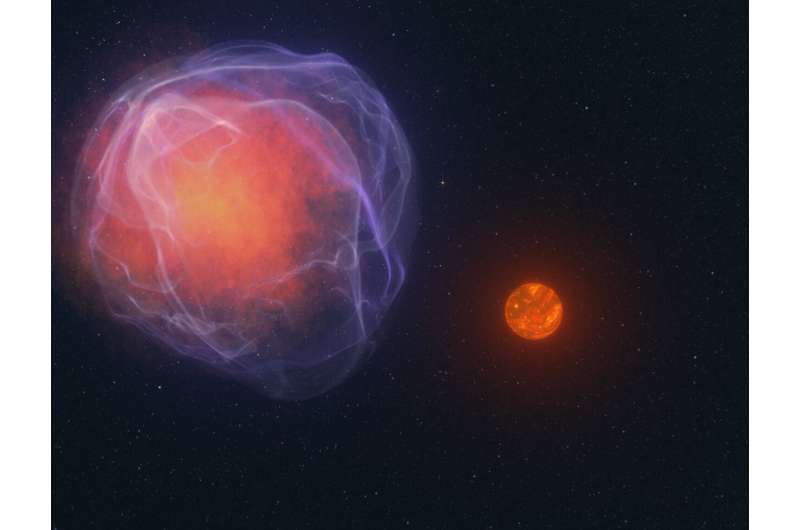
Artist’s illustration of a hypothetical white dwarf binary pair J1249+36 that ends with the white dwarf exploding in a supernova (left), which sends its sub-L dwarf star flying across the Milky Way. Credit: WM Keck Observatory/Adam Makarenko
Good morning! Here are some of this week’s coolest science stories to read while you’re snuggling up on the couch with your cup of General Foods International French Vanilla Cafe.
Hasty object
In the citizen science project Backyard Worlds: Planet 9, volunteers look for patterns in the vast ocean of data collected over the 14 years of NASA’s Wide-field Infrared Survey Explorer mission. They tag moving objects in data files, and when multiple volunteers flag the same object, astronomers investigate the finding.
However, this collective of volunteers recently spotted a faint red star tearing through the Milky Way at about 1.3 million miles per hour, or 600 kilometers per second, representing the discovery of the first low-mass, hypervelocity star and object closest to hyperspeed. the sun
This raises the obvious question: Why is this so fast? Researchers speculate that the object, named CWISE J124909+362116.0, may have been a subdwarf of a white dwarf binary system that was blasted into its current trajectory when the white dwarf exploded in a supernova. There is also a cooler theory that involves a pair of tightly bound black holes ejecting J1249+36 from a globular cluster.
Moving at 0.1% of the speed of light, J1249+36 is moving so fast that it will, in all likelihood, eventually escape the Milky Way.
Pests exhaust
New York City is famous for its bright lights, high-precision dance lines and chewy pizza crust. Where else in the world can you eat falafel on the street while an accordionist dressed as Boba Fett serenades passing junk bond brokers? Hey, I’m walking here! New York is also famous for its rats, a distinction it has undoubtedly earned and wears as a badge of honor not so much as depressed resignation.
For decades, the city has controlled rat populations with poison-baiting programs, which has had a major impact on other urban wildlife, including poor Flaco the owl, an escapee from the Central Park Zoo who excited New Yorkers for months before the fatal crash. in a building; a subsequent necropsy revealed high levels of rat poison in his system. The Mayor’s Office announced this year that the city will conduct a trial of a contraceptive baiting program to evaluate its effectiveness against poison campaigns.
However, researchers say birth control programs may not be an effective means of controlling rat populations. They cite several reasons, including the likelihood that many mice will not eat the bait and will produce offspring that similarly avoid it. However, they suggest that contraceptive baiting can contribute to a range of approaches to control the problem.
Plastic water
There’s a herd of Jon Snow Funko Pops the size of Rhode Island that’s been migrating with the tides around the Sargasso Sea since the third season of Game of Thrones. Look, I made that up, but there’s a true story about the 30,000 plastic ducks that started washing up on the coast of Alaska in 1992. And the ocean is really saturated with plastic and nanoplastic debris, as are fresh waterways, ecosystems and bodies of organisms, including humans.
If it seems like nanoplastics are a new, explosive problem that complicates many others, including climate change, you’re not wrong—consider that large-scale production of plastics only began in 1950, and fully half of all plastic in the world ever produced has been made since 2000 Nanoplastic pollution is indeed a new, scary problem, and as it becomes a threat to human health, researchers are looking for ways to eliminate nanoplastics from water.
Scientists at the University of Missouri now report a method that uses a small amount of a water-repelling solvent that removes 98% of nanoplastics from large amounts of water. The solvent, made from natural products, soaks into the surface of the water, floating like oil. When the water is mixed, the solvent separates and then floats back to the surface holding the nanoplastic within its molecular structure.
In the lab, the scientists removed plastic from the surface of the water using a pipette, but in future experiments, they plan to scale the process with an eye toward removing nanoplastic from large bodies of water.
© 2024 Science X Network
citation: Saturday Quotes: Citizen scientists observe the fast thing; control of rat populations; cleaning nanoplastics from water (2024, August 17) retrieved August 17, 2024 from https://phys.org/news/2024-08-saturday-citations-citizen-scientists-fast.html
This document is subject to copyright. Except for any fair agreement for study or private research purposes, no part may be reproduced without written permission. The content is provided for informational purposes only.